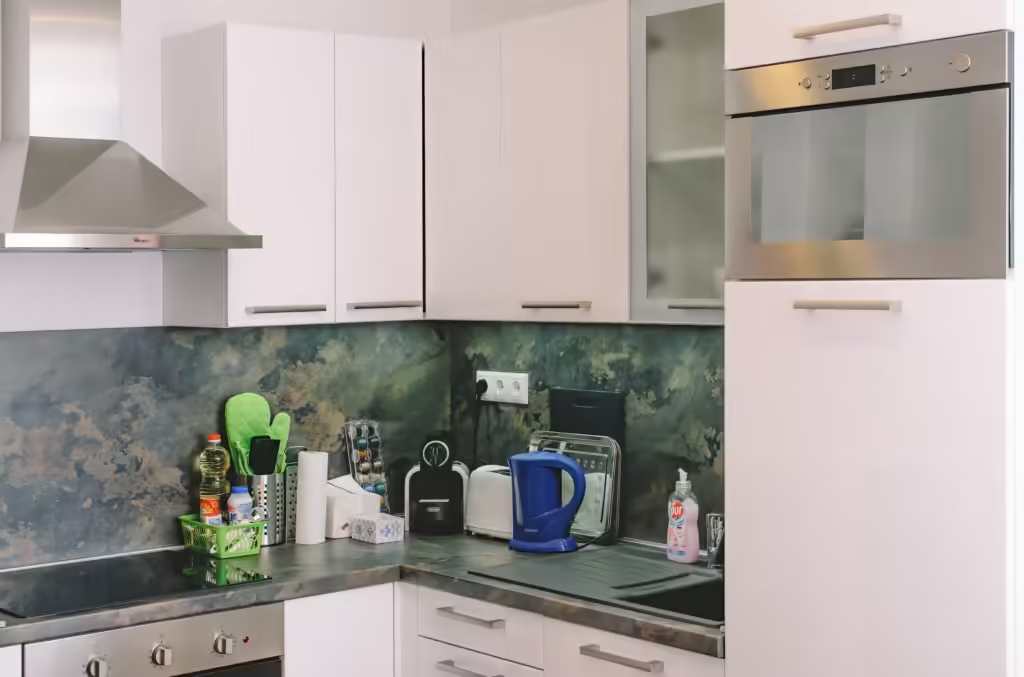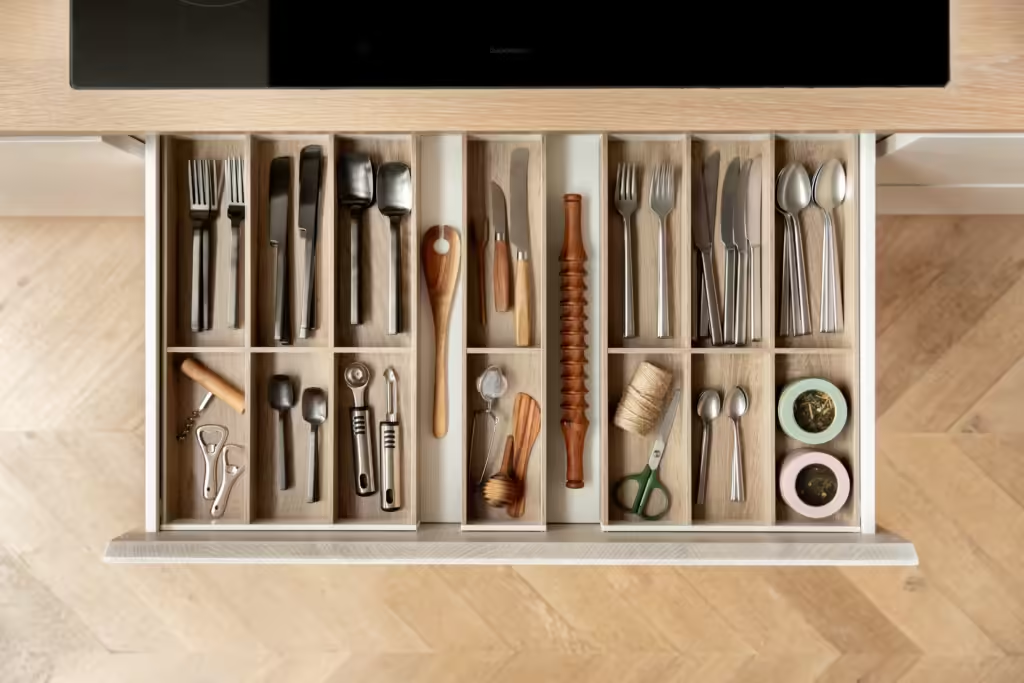
Small kitchens can often feel cramped and cluttered, making cooking and daily tasks more challenging than they should be. However, this should not be the case since there are always ways to make every space in the house as productive as possible depending on how it has been designed, which also applies to kitchens. In this article, we’ll discover some simple and original tips to make your small kitchen more functional and delightful so that you will enjoy it whenever you are cooking.
1. Utilize Vertical Space with Smart Storage Solutions
Among the best strategies for kitchen organization, there is one highly efficient – using the up-down space. Most of the time main walls and above counters are empty or only a small part is used for storage. Shelves and tall cabinets that go up to the ceiling are recommended for additional storage of things that are used sparingly like holiday dishes and other kitchen utensils.
It will be beneficial to incorporate extra open shelves or hanging units on the walls for reaching things such as spices, utensils, pots, and pans. It is not only important for leaving counter space but it also ensures that your kitchen items are easily accessible. The National Kitchen and Bath Association (NKBA) says that the effectiveness of using vertical space in the kitchen can be up to 20%* more efficient.
2. Opt for Multi-Functional Furniture and Appliances
In a small kitchen, every piece of furniture and appliance should serve more than one purpose. Moving shelves, transforming tables, or a block of worktop with a pull-out chopping board, shelf, and preparation area are space-efficient and multi-functional. Also, it is desirable to select devices that perform several related functions at the same time, for example, a microwave oven is also a convection oven, or a refrigerator dispenses water and ice.
According to a Houzz survey in 2023, 35% of small kitchen homeowners decided to install multi-functional appliances*. This trend is a clear indication that homeowners are now considering items that can be multi-functional, a factor that makes kitchens more efficient.
3. Incorporate Light Colors and Reflective Surfaces
Use the colors and finishes wisely to ensure that the room appears as big as possible no matter how small it is. Painting the walls and especially the ceilings in lighter shades, including white or cream, or even pastel colors may help expand a small space of a kitchen. These colors do reflect more light giving an impression of space and the light hue.
Glossy tiles, for example, shiny glass backsplashes, and steel-looking appliances will also increase this impact. These surfaces in their reflecting of the natural and artificial light assist in giving an effect of a larger space. It is interesting to know that, the local interior design specialists believe that the use of lighter shades and reflective material would make a room appear the size of up to fifty percent of its actual size*.
4. Maximize Cabinet Space with Organizational Tools

Even the smallest kitchens often have more storage space than you might think, but it requires the right organizational tools to fully utilize it. Organize your cabinets with pull-out shelves, or lazy Susan and tiered racks so that you can take advantage of any space. These tools assist in avoiding placing an item and never finding it in the back of the cabinet.
Another effective technique for organizing utensils and small items so they don’t clutter the space is drawer dividers. A study by The Container Store found that households using cabinet and drawer organizers experienced a 30% increase in kitchen storage efficiency*.
5. Create Illusions of Space with Strategic Lighting
Lighting is also very important when it comes to decorating a small kitchen to feel more open and spacious. From personal experience, natural light is perhaps the best way of creating an illusion of space, so free the windows of your kitchen from layer after layer of curtains and blinds.
Secondly, natural light should be complemented with artificial light sources such as under cabinets, pendants, or recessed lighting to illuminate the corners of the room and make the space look more open. According to lighting experts, well-lit kitchens not only appear larger but also improve functionality, making cooking and other tasks easier*.
6. Keep Countertops Clutter-Free
Clutter on a countertop will make even a huge kitchen look small and confined. Especially in the small kitchen, it is desirable to have as many free spaces on countertops as possible to avoid feeling stuffy. Small appliances including toasters, coffee makers, etc should be arranged in a cabinet or on shelves when not in use.
Some of the ways of saving space for countable items include using a wall-mounted magnetic knife strip, a hanging fruit basket, or hooks for the utensils. Messy countertops are not only unattractive but they also take up a lot of room which can make the kitchen less efficient and less comfortable to cook in.
7. Opt for Compact, Space-Saving Appliances
Since kitchens are rather limited in size in small homes, they must contain only the necessary and proportionate appliances. Convection ovens, slim fridges, or narrow dishwashers will allow you to get all the functionality that is required without occupying much space.
When selecting replacement appliances, consider small appliances appropriate for a small kitchen available in different designs and colors. Many design specialists advise to opt for small appliances in a small kitchen while keeping an eye on the aesthetic and practical aspect throughout the process of the appliances’ selection.
8. Incorporate Clever Storage Solutions in Unused Areas
Space in a small kitchen that is not being used can be very beneficial when converted into storage space. It’s also ideal to use niches, which you would otherwise occupy with litter, for storing things that are not used frequently, such as serving dishes and large pots that have a good place on the upper part of your refrigerator. You can also create shelves or cabinets over the stove or in some other useless corner.
Toe-kick drawers on the lower side of your cabinet is another proper way of utilizing space that is unused. These hidden drawers are ideal for storing flat items such as baking sheets or cutting boards and this means you minimize clutter in the kitchen.
9. Design with Space Efficiency in Mind
When designing a small kitchen, it’s essential to prioritize space efficiency from the outset. However, it can be challenging to do with a small kitchen space, thus the need to plan it effectively from the start. This includes thinking through the positioning of the components, deciding how big or small each of them is going to be, and checking that everything has its proper location.
One of the biggest benefits of hiring a professional designer, especially one that has prior experience designing with the Solidworks design software, is the ability to design a kitchen that suits your space perfectly without compromises.
If you know how to work with Solidworks design software and are looking for opportunities to apply your skills, explore Solidworks remote job openings that allow you to work on innovative kitchen designs from anywhere.
10. Keep It Simple and Minimalistic
Last but not least, one of the most effective strategies for getting the best of your small kitchen is to declutter. Do not crowd your kitchen beyond measure but rather ensure that only the very important utensils and equipment are present. Having a particular style that minimizes utensils and other items also makes the kitchen look less busy, and certainly more distinguishable in terms of space.
Through a minimalist approach of using smooth curves and lines and avoiding the use of too much ornamentation in the design, you can effectively design a minimalist and welcoming kitchen even in a small space.
Getting more space in a small kitchen is all about the right design ideas added to the right furniture and the right way of working and keeping the kitchen clean. All these easy ideas will ensure you obtain the best kitchen design regardless of your kitchen size or style of cooking and dining.
*Sources: National Kitchen and Bath Association, Houzz, The Container Store.
- 0shares
- Facebook0
- Pinterest0
- Twitter0



